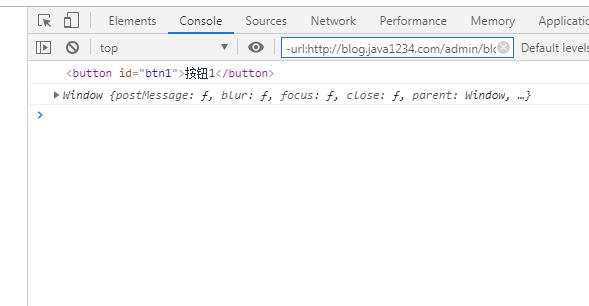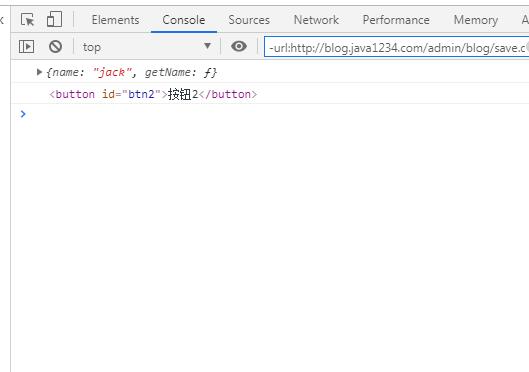
es6箭头函数
发布时间:『 2019-06-10 23:15』 博客类别:Vue.js
在es6中,推出了一个新语法 箭头函数;
以前定义一个函数,是这么定义的;
let fun=function(){
console.log('我是箭头函数');
};
现在可以简化下,用箭头函数:
let fun=()=>{console.log('我是箭头函数')};
然后假如函数体只有一条语句或者是表达式的时候{}可以省略
let fun=()=>console.log('我是箭头函数');
加形参情况;
let fun2=(a)=>console.log(a);
只有一个形参的时候 ()可以省略
改成:
let fun2=a=>console.log(a);
多个形参:
let fun3=(x,y)=>console.log(x,y);
fun3(20,30);
有返回值情况:
let fun6=(x,y)=>{
console.log(x,y);
return x+y;
}
console.log(fun6(1,3));
关于 箭头函数里的this;(重点)
箭头函数没有自己的this,箭头函数的this不是调用的时候决定的,而是再定义的时候所在的对象就是它的this
箭头函数的this看外层是否有函数,
如果有,外层函数的this就是内部调用箭头函数的this
如果没有,则this是window
<!DOCTYPE html>
<html>
<head>
<meta charset="UTF-8">
<title>Title</title>
</head>
<body>
<button id="btn1">按钮1</button>
<button id="btn2">按钮2</button>
<script type="text/javascript">
let btn1=document.getElementById('btn1');
let btn2=document.getElementById('btn2');
btn1.onclick=function(){
alert(this);
};
btn2.onclick=()=>{
alert(this);
}
</script>
</body>
</html>
可以看出 点击 按钮1 这里的this是 调用的时候的btn1对象;
而点击按钮,this是window对象;
再来个复杂点的实例,来深入理解下:
箭头函数搞到定义对象的回调函数里;
<!DOCTYPE html>
<html>
<head>
<meta charset="UTF-8">
<title>Title</title>
</head>
<body>
<button id="btn1">按钮1</button>
<button id="btn2">按钮2</button>
<script type="text/javascript">
let btn1=document.getElementById('btn1');
let btn2=document.getElementById('btn2');
let person1={
name:'jack',
getName:function(){
btn1.onclick=()=>{
console.log(this);
}
}
}
person1.getName();
let person2={
name:'Marry',
getName:function(){
btn2.onclick=function(){
console.log(this)
}
}
}
person2.getName();
</script>
</body>
</html>
因为箭头函数是定义再对象的回调方法里,所以这里的this是person1;


Java1234_小锋
(知识改变命运,技术改变世界)
- Java核心基础(145)
- QQ第三方登录(6)
- mybatis-plus(20)
- Mycat(30)
- Layui(2)
- Mysql(2)
- Docker(35)
- Dubbo(7)
- 007项目(0)
- SVN(22)
- SpringCloud(33)
- Tomcat(6)
- 支付宝接口(3)
- NodeJs(1)
- IDEA(24)
- SpringBoot(11)
- 微信扫码登录(4)
- Git(50)
- Nginx(24)
- Vue.js(50)
- jsoup(6)
- shiro(1)
- Redis(17)
- maven(6)
- 活动(20)
- hibernate(1)
- EhCache缓存框架(4)
- webservice(10)
- CAS单点登录(7)
- elasticsearch(31)
- log4j日志(8)
- IT之路(26)
- activiti(26)
- centos(25)
- java爬虫技术(14)
- 随心生活(19)
- 网站SEO(2)
- htmlunit(10)
- httpclient(7)
- 2022年12月(1)
- 2021年10月(1)
- 2021年02月(3)
- 2020年11月(3)
- 2020年10月(4)
- 2020年09月(7)
- 2020年08月(18)
- 2020年07月(21)
- 2020年06月(37)
- 2020年05月(17)
- 2020年04月(12)
- 2020年03月(10)
- 2020年02月(14)
- 2020年01月(12)
- 2019年12月(15)
- 2019年11月(27)
- 2019年10月(5)
- 2019年09月(1)
- 2019年08月(4)
- 2019年07月(28)
- 2019年06月(16)
- 2019年05月(4)
- 2019年04月(3)
- 2019年03月(2)
- 2019年02月(7)
- 2019年01月(20)
- 2018年12月(2)
- 2018年11月(5)
- 2018年10月(30)
- 2018年09月(11)
- 2018年08月(5)
- 2018年07月(9)
- 2018年06月(4)
- 2018年05月(4)
- 2018年04月(3)
- 2018年03月(7)
- 2018年02月(6)
- 2018年01月(13)
- 2017年12月(3)
- 2017年11月(10)
- 2017年10月(1)
- 2017年09月(9)
- 2017年08月(12)
- 2017年07月(19)
- 2017年06月(21)
- 2017年05月(1)
- 2017年04月(12)
- 2017年03月(13)
- 2017年02月(12)
- 2017年01月(14)
- 2016年12月(8)
- 2016年11月(25)
- 2016年10月(16)
- 2016年09月(13)
- 2016年08月(20)
- 2016年07月(12)
- 2016年06月(36)
- 2016年05月(10)
- 2016年04月(19)
- 2016年03月(14)
- 2016年02月(23)
- 2016年01月(1)
Powered by Java1234 V3.0
Copyright © 2012-2016 Java知识分享网 版权所有